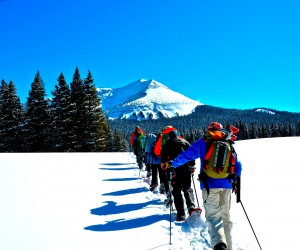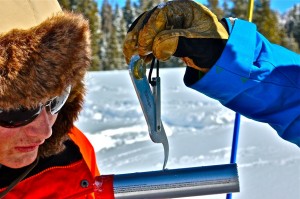25 Mar TELLURIDE MOUNTAIN SCHOOL INVESTIGATES LOCAL WATERSHED
Editor’s note: For two weeks, Telluride Mountain School High School students put aside textbooks and turned their attention to water. With the help of local experts on water and media, they researched, wrote, and presented everything there is to know about Telluride water– where it comes from, how it’s cleaned, and what the fate of future snowpack is. This first entry, by senior Claire Ricks, is part one of a five-part series on Telluride water….
Two Weeks Full of Water
by Claire Ricks
These days, I have a hard time remembering to drink enough water. Sixty-four ounces a day,
I’m told, is ideal. In the morning, however, I don’t even think about the fifty gallons I use
in a twenty-minute shower. Let alone where it comes from and where it goes afterward. I rare-
ly think about water. At least when it’s not making a beautiful river or at that beach where I’d
love to be. After this week, though, water use will be on my mind much more.
It started with three seniors, four sophomores, nine freshmen—all in one foul-smelling room. And it wasn’t because of the freshmen this time. We were at the water treatment plant for our little town, Telluride. This is where all the toilet flushes, all the relaxing showers, everything that goes down any drain, ends up. Therefore, the smell.
Here, water is treated and put back in the river. Bella Hamm’s “Bugs in Your Water” gives a different insight into the bacteria and “bugs” used to treat wastewater.
Turns out water moves in a cycle; the snowpack we all measured the day before, some of it melted, turned into runoff, made its way down in creeks and rivers,
which ended up in my faucets, was used, went down the drain, traveled to the water
treatment plant, was treated, and entered the river once again. Read Theo Rolf’s
article, “Snow, Telluride’s Cold Commodity” to understand that the snowpack affects everyone throughout the year. Skiers in winter, farmers in the summer. And anyone who likes water.
People like John Duncan, the owner of Telluride Outside, gave us a narrative on how
water affects his livelihood. Duncan runs a guiding company and if there is not enough water in the rivers from the snowpack’s runoff, he cannot send people out in rafts. An entire industry shorted.
The Telluride Mountain School’s entire high school studied water, wrote about water, and took photographs of water. Two weeks full of water. And I must say, I think this was important— if not vital—in the changing climate we are living in. Water is everything to humans. We live with water, and without water, we wouldn’t be here. Now, in this day and age, most of our water use is unnecessary.
Is it imperative that I use 3.5 gallons per toilet flush? And do I really need that shower to survive? Maybe.
But I can’t say that many high schoolers across the United States know exactly where their water comes from, where it goes after they use it, and what snowpack has to do
with farming in the summer. At the Mountain School, though, we do.
Check out this podcast with Micah Hesse to learn more about Mountain School’s journey up to Lizard Head to investigate local snowpack.




Sorry, the comment form is closed at this time.